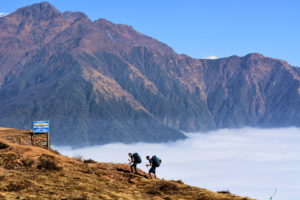Mountain Hiking is one of those more “extreme” versions of hiking, as it has a lot of potential to give you the rush, the feel of nature, and the breath of fresh air that other hiking trails can’t replicate, or if they can, it’s not as prominent as the feeling here.
But at the same time, mountain trails also have unique risks and problems that can make scaling them more difficult and dangerous. For instance, some conditions that would cause a hiker to be uncomfortable but not enough to ruin a trail trek in a forest hike might be cause for alarm for a hiker up in the mountains to seek shelter immediately.
Which is why this article is here to give you an idea of what you should watch out for if you decide to go mountain hiking.
Extreme weather problems
Weather is always a wild card, and something you should never consider to be stable.
Even if the forecast calls for sunshine and there is nary a cloud in the sky, it can easily change for the worse at a pace you would never expect.
Harsh winds and lightning storms are just a couple of weather patterns that can disrupt your hike, but there are also things like heavy fog that skew your vision and make hiking dangerous, forcing you to hunker down until it disappears.
This doesn’t even go into things like heavy snowstorms and extremely cold rain (because mountain temperature is quite cold).
Altitude
Altitude is definitely a risk, especially as the air is thinner when climbing up very high mountains.
However, it is not as big a risk as many things on this list are, as most mountains do not ever reach the point that it becomes dangerous, and unless you are scaling something like Mount Everest, it should not ever be a problem for an average hiker.
Still, exercise caution when scaling mountains, as it can still be exhausting and potentially cause breathing troubles if you don’t pace yourself accordingly.
Body temperature
Hypothermia is an issue in any hiking trail and is a very prominent problem in mountain hiking.
Temperatures can drop low really fast, especially at higher altitudes as there is less air to insulate and less oxygen to warm the body.
Make sure you are dressed appropriately, as it can be dangerous to your body especially if the temperature drops a lot.
Landslides
Landslides are usually caused by a heavy downpour of rain, and my occur before or after the rainstorm has passed.
As a result, trails that have experienced a particularly strong shower may not open their trails until after some time has passed, due to the danger of ground possibly splitting and causing landslides.
If a trail that catches your eye just came from a rainstorm, you may want to change your mind to a different one.
Avalanches
Avalanches are like landslides, but instead of the ground shifting, it’s snow shifting. This primarily happens in snowy regions or during winter and can be dangerous especially if the snow is melting.
It is best to avoid trails that might potentially have this happen to keep safe, as one will not have too much time to react when an avalanche occurs.
Wildlife
Like any other trail, expect to possibly run into animals on the trail. For some, you may see something that will not attack you on sight like a mountain goat but seeing bears on the trail is not unheard of.
Being at a high altitude and uneven terrain makes movement a bit tricky, and sometimes paths can get narrow that an animal in the middle of the path can spell the end of your trek, as it is too risky to approach.
To ensure that you don’t get surprised by what wildlife a hiking trail contains, always do your proper research to find out as much as you can about the actual wildlife that lives on a specific trail.
Other people
Who knew other people could actually be dangerous to you as well? It turns out that even if you are one of those people who know all about the dangers and know-hows of mountain climbing, and are fully prepared to handle for any possible contingencies, there is no guarantee that the strangers who are currently climbing above you are the same.
Other humans themselves are a risk-factor for the simple fact that their actions can cause danger for all those currently involved in the hike, especially since mountain dangers like avalanches and rockslides have a higher chance to cause a chain reaction for those at the lower part of the mountain. It doesn’t help that some of them might be incompetent, inexperienced, inattentive, and just all-around not prepared to handle mountain climbing at all, at least not without causing danger for all those involved.
Listing all dangers of mountain climbing is an improbable task, but most of them simply require your wit, attention, and common sense to breeze through without any issues, and nowhere is this shown more than being cautious and attentive to your fellow humans on the trail and how they are doing.

